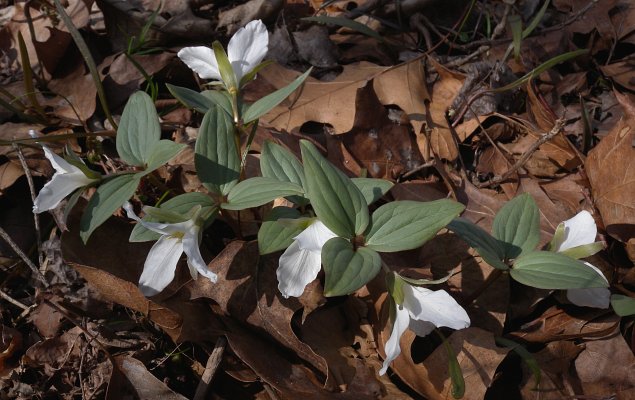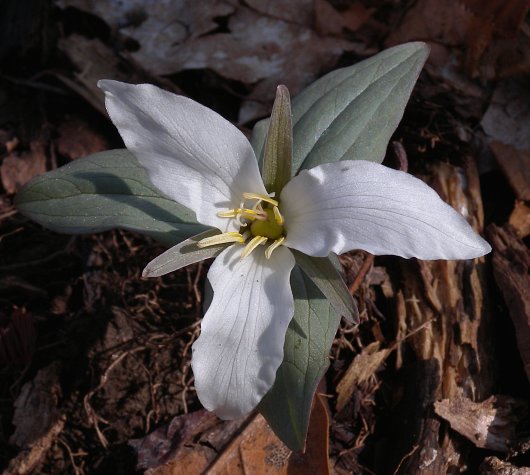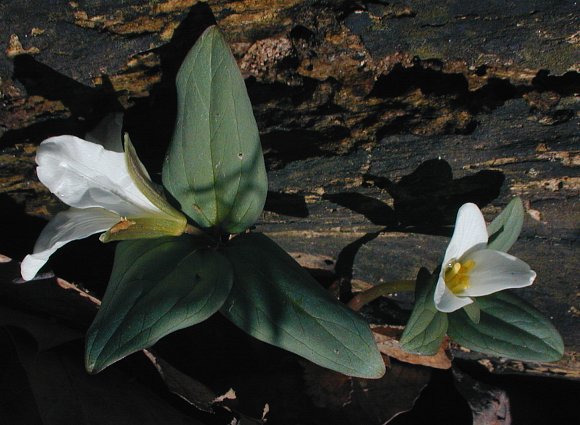Description: This perennial plant is 2½–6" tall and unbranched. It produces a single glabrous stem that terminates in a whorl of 3 leaves. The stem is light green, sometimes with reddish brown tints. The leaves are up to 2½" long; they are green or olive green, oval to ovate, hairless, and smooth along the margins. Their leaf venation is parallel. The base of each leaf is more rounded than its tip; it has a short petiole. Mature plants produce a single flower on a short peduncle about ½" long that is straight or arching (usually the latter).

The flower is up to 2" across, consisting of 3 white petals, 3 green sepals, 6 yellow stamens, and a a tripartite style. The petals are oval-ovate and often slightly undulate along their margins. The recurved sepals are lanceolate and often slightly reddish or yellowish on the outer surface. The blooming period occurs during early to mid-spring and lasts about 2 weeks. Each fertilized flower is replaced by a 3-lobed fruit that is about ½" long. The root system consists of a thickened rootstock, secondary feeder roots, and rhizomes. Snow Trillium can reseed itself, but it more often produces vegetative clones from the rhizomes. At favorable sites, colonies are often formed.

Cultivation:
The
preference is filtered sunlight during the spring (before the trees
leaf out), and light shade during the summer. The soil should be mesic
to dry, and loamy or rocky with a shallow layer of decaying leaves.
There should not be too much competition from other ground layer plants
during the late spring or the summer. The foliage withers away by the
end of summer.
Range & Habitat:
The native Snow Trillium occurs in central and northern Illinois, where
it is
rather uncommon (see Distribution
Map). However, it is locally common at a few high quality
sites. Habitats include thinly wooded bluffs, upper slopes of bluffs
(especially along rivers), and upper banks of rivers. This is an
indicator species of
high quality woodlands.
It grows where the layer of decaying leaves is not too thick.

Faunal Associations: Very few insects visit the early-blooming flowers for nectar or pollen. Most likely, the flowers are pollinated by Andrenid bees (Andrena spp.), queen bumblebees, and other bees that become active early in the spring. The caterpillars of two polyphagous moths, Clepsis melaleucana (Black-Patched Clepsis) and Euplexia benesimilis (American Angle Shades), feed on trilliums (Trillium spp.) occasionally. The fruits are probably eaten by small mammals and birds, although there is a lack of information regarding the particular species that do this. Such animals can help to introduce the seeds into new areas. Deer are very partial to the foliage of trilliums, although the Snow Trillium may be less vulnerable to their browsing than others because of its small size and strong tendency to grow on inaccessible slopes.

Photographic
Location:
The slope of a bluff in Vermilion County, Illinois, and a river bank at
Allerton Park in Piatt County, Illinois.
Comments: This
is one of the earliest wildflowers to bloom in woodlands and it is the
smallest trillium (Trillium
sp.). The Snow Trillium can be distinguished from other
white-flowered Trilliums by considering the following features: 1) It
is only 2-4" tall while in bloom, 2) it blooms earlier in the spring
than other trilliums, 3) it has white flowers on a short stalk that is
erect or arching, and 4) each fruit has 3 conspicuous lobes. The common
name refers to the fact that snow can be found on the ground when the
flowers bloom. This cute little trillium should be protected wherever
it is found.